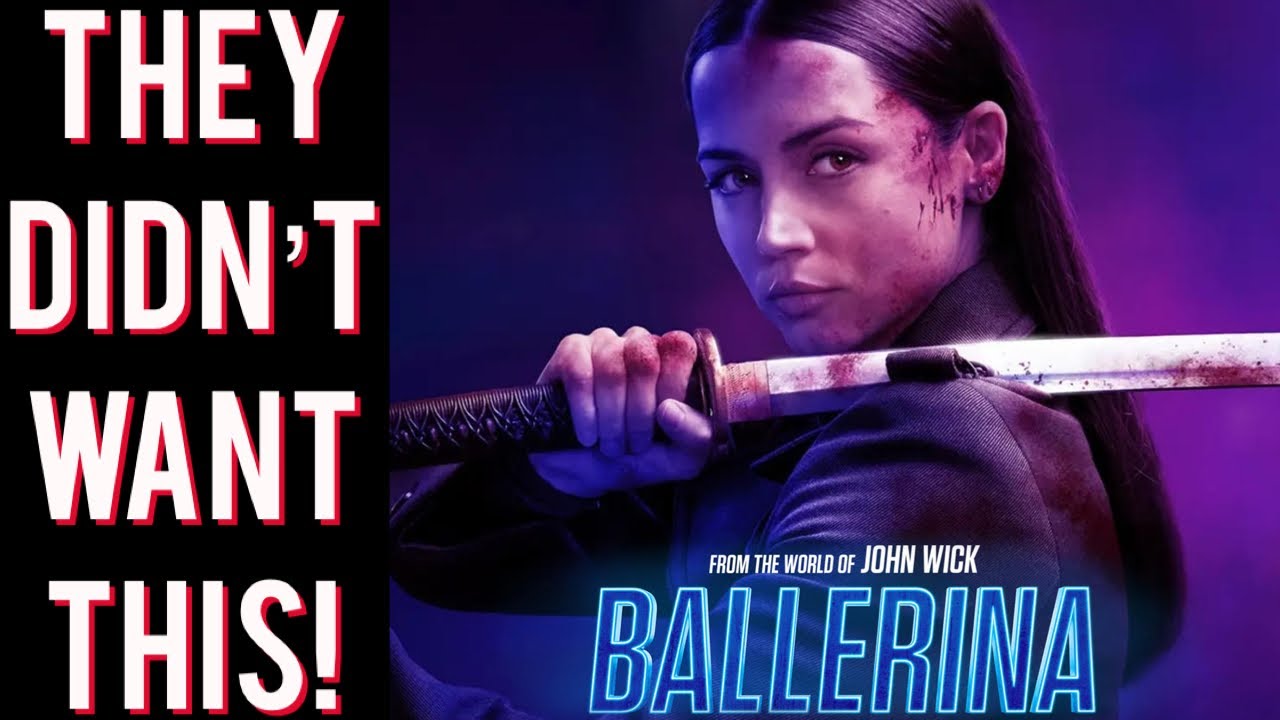Ballerina’s Box Office Bust: What It Means for Female-Led Action Films
The John Wick franchise, launched in 2014 with Keanu Reeves’ stoic assassin, has become a cornerstone of modern action cinema, known for its balletic fight choreography and expansive underworld mythology. Its fifth installment, From the World of John Wick: Ballerina (2025), directed by Len Wiseman and starring Ana de Armas as Eve Macarro, a ballerina-turned-assassin, aimed to expand this universe with a female-led spin-off. Released on June 6, 2025, the film promised to blend the franchise’s signature action with a fresh perspective. Yet, its disappointing $25 million domestic opening weekend, the lowest since the original John Wick’s $14.4 million debut, has sparked claims that “women ditched” the film and that Hollywood has “doomed” female-led action movies. This article explores Ballerina’s performance, the gender dynamics of its audience, and whether the genre is truly in peril.

Ballerina’s Box Office: A Stumble Out of the Gate
Ballerina, set between John Wick: Chapter 3 – Parabellum (2019) and Chapter 4 (2023), follows Eve Macarro, a Ruska Roma-trained assassin seeking revenge for her father’s murder. The film boasts a $90 million budget, a star-studded cast including Gabriel Byrne, Norman Reedus, Catalina Sandino Moreno, Anjelica Huston, Ian McShane, and Keanu Reeves in a supporting role, and a 126-minute runtime packed with inventive action. Early projections estimated a $35 million domestic opening, later adjusted to $30 million, but the final $25 million haul fell short, placing it second behind Disney’s Lilo & Stitch remake, which topped the box office in its third week.
The John Wick franchise has seen consistent box office growth: Chapter 2 (2017) opened at $30.4 million, Chapter 3 at $56.8 million, and Chapter 4 at $73.8 million. Ballerina’s performance, while surpassing the original’s modest debut, marks a step back from this upward trajectory, especially given the franchise’s established brand. Foreign sales reportedly offset much of the budget, and the film earned an A- CinemaScore and a 94% audience score on Rotten Tomatoes, indicating strong approval from those who attended. However, the soft domestic turnout, particularly among female audiences, has fueled debate. PostTrak data shows 63% of opening weekend moviegoers were male, suggesting women were underrepresented compared to expectations for a female-led film.
On X, posts amplified this narrative, with users claiming “women ditched” Ballerina and that Hollywood’s push for female-led action is failing. Some pointed to the film’s marketing, which heavily emphasized Ana de Armas as a “fierce” action star, as potentially alienating audiences by framing the film as a “for her” product. Others argued the crowded June 2025 market, with competitors like Mission: Impossible – The Final Reckoning and Lilo & Stitch, diluted its appeal. These sentiments, while vocal, lack granular data on audience demographics beyond PostTrak’s initial breakdown, making claims of women “ditching” the film more speculative than definitive.
The Film: Strengths and Weaknesses
Ballerina’s narrative centers on Eve’s quest for vengeance against the Cult, a rival faction to the Ruska Roma, after her father’s death. Trained as both a ballerina and a Kikimora assassin under the Director (Anjelica Huston), Eve navigates a mountain village of killers, facing off against foes like the Chancellor (Gabriel Byrne) and her long-lost sister, Lena (Catalina Sandino Moreno). The film’s action, choreographed with the franchise’s signature flair, includes creative set pieces involving grenades, flamethrowers, roller skates, and a plate-smashing brawl. Ana de Armas’ performance has been widely praised, with critics noting her ability to blend elegance with ferocity, distinguishing Eve’s scrappy combat style from John Wick’s polished precision.
The film’s strengths lie in its action and world-building. It expands the John Wick universe with new factions and locations, like the Prague Continental and the Cult’s assassin-filled town, while tying into Parabellum through Eve’s encounters with John Wick and Winston (Ian McShane). Keanu Reeves’ supporting role, more substantial than a cameo, adds legitimacy, though some argue it overshadows Eve’s story. The action sequences, described as “propulsive” and “mind-blowing,” rival the franchise’s best, with standout moments like Eve retracing a trail of bodies to her car.
However, Ballerina has flaws. Its plot is often criticized as formulaic, leaning heavily on revenge tropes without the emotional depth of the original John Wick. The dialogue, laden with repetitive themes of duality (choice vs. fate, protection vs. destruction), feels clunky, detracting from the action’s impact. Some viewers found the 126-minute runtime bloated, particularly in the first act, which struggles to establish Eve’s motivations. These issues may have contributed to its softer turnout, as word-of-mouth relies on more than just action spectacle.
Female-Led Action: Doomed or Misunderstood?
The claim that Ballerina’s performance “dooms” female-led action movies stems from a broader narrative about Hollywood’s struggles with the genre. Action films have historically been male-dominated, with women often relegated to damsel or sidekick roles. The 2010s saw a shift, with films like Atomic Blonde (2017, $100 million worldwide), Mad Max: Fury Road (2015, $375 million), and Wonder Woman (2017, $822 million) proving women could lead high-octane blockbusters. Ballerina was positioned to follow this trend, leveraging Ana de Armas’ rising star power from No Time to Die (2021) and the John Wick brand. Yet, its box office stumble has reignited skepticism about the genre’s viability.
The PostTrak data showing a 63% male audience suggests Ballerina failed to attract women as hoped. This mirrors other recent female-led films, like The Marvels (2023, $274 million loss) and Birds of Prey (2020, $205 million worldwide), which underperformed despite strong reviews. On X, some users argue that women avoid these films due to marketing that feels pandering or because action genres inherently appeal more to men. Others counter that Ballerina’s marketing didn’t sufficiently highlight its emotional core—Eve’s quest for family and justice—which might have resonated with female viewers.
However, the “doom” narrative is overstated. Atomic Blonde, starring Charlize Theron, succeeded with a $30 million budget and gritty, authentic action, proving the concept’s potential. Wonder Woman and Captain Marvel (2019, $1.13 billion) show that female-led action can thrive with strong storytelling and broad appeal. Ballerina’s issues seem less about its female lead and more about execution and market dynamics. Its A- CinemaScore suggests audiences who saw it were satisfied, and its 94% Rotten Tomatoes audience score indicates a disconnect between viewers and non-viewers, possibly due to marketing missteps or competition.
Industry Context: A Crowded Landscape
Ballerina’s release came at a challenging time. June 2025 saw a saturated market, with Lilo & Stitch drawing family audiences and Mission: Impossible – The Final Reckoning competing for action fans. The John Wick franchise, while beloved, faces risks of oversaturation, with Chapter 5 in development and The Continental TV series receiving mixed reception. Some X posts express fatigue, arguing the series should have ended after Chapter 3, a sentiment that may have dampened enthusiasm for spin-offs.
Lionsgate’s strategy to expand the John Wick universe hinges on diversifying its leads while maintaining the franchise’s core appeal: stylish action and world-building. Ballerina succeeds in this regard, but its marketing may have overemphasized Ana de Armas’ star power over the franchise’s established draw—Keanu Reeves and relentless action. The decision to position it as a “female-led” film, while accurate, risked alienating some fans, as seen in 2019 X posts criticizing the concept before casting was even confirmed.
Cultural and Gender Dynamics
The claim that “women ditched” Ballerina taps into a broader cultural debate about gender in action cinema. Historically, action films have skewed male in both audience and protagonists, with stars like Stallone, Schwarzenegger, and Reeves defining the genre. Female-led action films often face higher scrutiny, expected to prove their worth in a way male-led films rarely do. Atomic Blonde and Kill Bill (2003-2004, $333 million combined) succeeded by prioritizing character and style over gender, while Ballerina’s marketing leaned heavily on its “female-centric” angle, potentially framing it as a niche product.
The 63% male audience suggests Ballerina attracted the franchise’s core demographic—men drawn to John Wick’s action—but failed to broaden its reach. Women may have been deterred by the film’s violent tone, which includes brutal fight scenes where Eve takes significant punishment, or by marketing that didn’t emphasize her emotional journey. Conversely, films like Everything Everywhere All at Once (2022, $143 million) show women can embrace action with compelling narratives, suggesting Ballerina’s shortfall is specific, not genre-wide.
Implications for Hollywood
Ballerina’s performance doesn’t doom female-led action but highlights lessons for Hollywood. First, marketing matters: framing a film as “for women” can backfire if it feels forced, whereas universal themes like revenge and family resonate broadly. Second, execution is key: Ballerina’s weak plot and dialogue undercut its stellar action, unlike John Wick’s lean, emotionally driven debut. Third, timing and competition can’t be ignored; releasing amid heavyweights like Mission: Impossible requires sharper differentiation.
The genre remains viable. Upcoming films like Thunderbolts (2025), with Florence Pugh’s Yelena Belova, and potential Atomic Blonde sequels suggest studios still see potential in female-led action. Ballerina’s strong audience scores indicate it could find a second life on streaming, where John Wick films have thrived. Lionsgate’s investment in the franchise, including Chapter 5, shows confidence in its long-term viability, but future spin-offs may need to balance novelty with fidelity to the series’ roots.
Conclusion
Ballerina’s $25 million opening and male-skewing audience don’t spell doom for female-led action movies but underscore the challenges of expanding a beloved franchise. Ana de Armas shines as Eve Macarro, and the film’s action honors the John Wick legacy, but its formulaic plot and marketing missteps limited its reach. Claims that “women ditched” the film oversimplify a complex picture, ignoring competition, audience fatigue, and the need for universal storytelling. Hollywood’s path forward lies in crafting authentic, well-executed films that transcend gender, as Wonder Woman and Atomic Blonde have done. As Ballerina twirls onto streaming, its legacy may yet grow—proof that even a stumble can lead to a graceful recovery.





